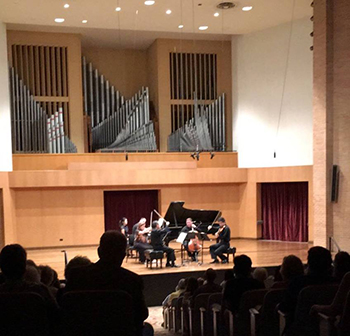by Nicholas Stevens

As the ensemble launched into Haydn’s Quartet in D minor (“Fifths”) on July 11, the acoustics of Kent State University’s Ludwig Recital Hall conveyed their sound with striking directness. The players’ convincing take on the piece came through loud and clear. A true leader with both precision and passion on his side, first violinist Benny Kim made the task of managing these mood swings look easy.
Kinetic activity alternated with lyricism in the first movement, and shimmery vibrato lent brilliance to lighter moments. Cellist Keith Robinson radiated energy, propelling the entire group forward. The second movement, labeled Andante, sounds suspiciously like a slow minuet –– it gives the impression of two characters at the same ball, one devastated and the other happily woozy. Second violinist Cathy Meng Robinson’s dark sound makes her the perfect foil for the more extroverted Kim, and the pair’s tradeoffs of material here revealed both their tonal differences and their equal prowess. Violist Scott Lee and Keith Robinson created another sort of contrast with their fierce, unified playing in the piece’s actual minuet movement. Lee stood out at a number of key moments, unafraid to shine.
Pēteris Vasks’ severe yet emotionally urgent String Quartet No. 3 plunged listeners into the sort of tragic moods that the Haydn suggests but avoids. Kim furnished clean, high harmonics in the first movement, and Meng Robinson and Lee pulled ominous tapping noises from their strings. In a unison passage in the second movement, the four players demonstrated a remarkable ability to match tone qualities. Their performance of the third movement had all the angst of a Shostakovich Adagio, but bustled along without leaving time to process these gripping outpourings. In the final movement, each player took up a high trill, as the others gathered to spread a warm blanket of lush major chords below. This texture alternated with a busier, less-interesting one.
To conclude the evening, Myer joined the Miami for Dvořák’s Quintet No. 1, an early work. He led with a bold solo statement, his left hand opening up a chasm that gave the right-hand line room to resonate. Of the three movements, the first bears the closest resemblance to the mature Dvořák. The ensemble made its best moments sound as miraculous as anything the composer would write later on. The second movement sounds a bit less like the composer’s work, though it afforded Robinson a chance to shine in a brief cello solo, and gave Myer another opportunity to define the movement’s mood straightaway. The five players remained tightly coordinated and energetic through the final movement, which ends with sparkling piano writing and a relentless drive to resolution.
Published on ClevelandClassical.com July 17, 2018.
Click here for a printable copy of this article

